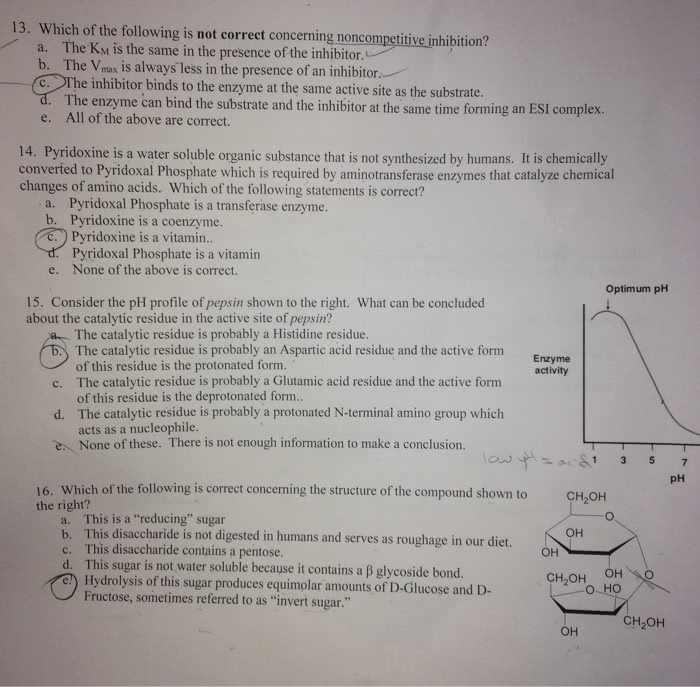KNES 464 Lecture Notes - Lecture 12: Intramuscular Injection, Blood Sugar, Lipase
Lecture 12
V max is a rate
Km is a concentration (at which half of v max is reached)
If add more enzyme
- V max changes and Km stays the same
o Velocity will be faster at Km but the Km (concentration will stay the same)
Competitive Inhibitor
- V max stays the same, but Km changes
o Eventually if you put in enough substrate, that will outcompete the inhibitor and
will eventually bid so V max is same but Km changes (takes more substrate to get
there)
Noncompetitive inhibitor
- V max changes but Km stays the same
o Certain amount of inhibitor that is always bound and will not be able to use the
enzymes, so Km changes
ATP levels don’t necessarily falls- the ATP level stays the same
- Don’t lose ATP levels
- Energetically compromised because of buildup of ADP and Pi
o ATP is energy currency of cells
o ADP and Pi go up
▪ Every ATP is worth less
▪ ATP amount doesn’t change, but the ADP and Pi increase, and the
amount of ADP and Pi start to get closer to equilibrium, so we get tired
Lipid Metabolism & mitochondrial Metabolism I
- Albumin is a transport molecule for fatty acids (they cannot just dissolve)
o Transported in blood stream and then brought to muscle
o Endurance athletes will have more fat because they need it
▪ Type II diabetes sotre a lot of this also because they have diminished
glucose score in muscle and stores it here as intramuscular triglycerides
▪ Atheltes paradox—why don’t they look the same—athletes and type II
diabetes
• They bth
▪ Sprinter will not use fat really
o Can fuel a lot of energy but just slower
Fatty Acid Transport
- Lipase will break off the
- Free fatty acids will then be brought to the muscle cell
o Off load and reload fatty acids
- Fatty acids are transported into muscle cell by FABP, FATP, or FAT/CD36
Mitochondria
- Have 2 membranes
o Outer membrane—
▪ Pretty permeable
• Everything goes through it
o Inner membrane
▪ Not so permeable
▪ Control what gets to be transported into mitochondria
▪ Glucose molecule
• When turn pyruvate to lactate→ you get 2 NAD+
▪ Anaerobic glycolysis and start with glucose end up with 2 lactates, then
net gain of ATP is 2 ATP, and 0 NADH because the 2 NADH went to NAD
• Start with glycogen→ get 3 ATP
o If you end up with pyruvate—then get 2 NADH
o If you end up with lactate—then get 0 NADH
Transport into Mitochondria
- Pyruvate—can go to lactate or oxidation in mitochondria
- Pyruvate transporter-- permeable to inner membrane and can enter the mitochondrial
matrix
o Has its own transporter
o But fat is a pain
- Start with fatty acids→Acyl CoA
o ACS are permeable to outer membrane
▪ They cannot get transported into inner mito membrane
o Have to turn Acyl CoA into carnitine
▪ Take the CoA and turn it into a Acyl Carnitine, which then gets
transported into membrane because it is permeable and then the Acetyl
carnitine then turns into Acyl CoA (turn back into Acetyl CoA once they
hit the matrix
o Inner mito membrane is impermeable to Acetyl CoA
Beta Oxidation
- Break down Acyl CoA to Acetyl CoA
- We now have the Acyl-CoA in the mitochondria
o Acyl-CoA need to be truncated into Acetyl-CoA
- Glycolysis for lipids—fat glycolysis
- Net inputs and outputs
o Beta oxidation has 4 enzymes
▪ FAD→ FADH2
▪ NAD+→ 1 NADH (reduce to NADH)
▪ Acyl CoA and form


